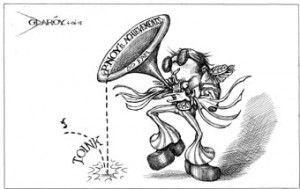
To be sure, the abduction in Agusan by Manobo tribesmen demanding the release of a fellow tribesman campaigning for ancestral domain rights for the lumad group is separate from the rest of the violent incidents, which appear germane to the Muslim Mindanao question. But its potential for violence—again, if violence hasn’t yet really broken—melds with the Muslim issue and everything else about Mindanao, the intractability of its many-sided conflict, and its resistance to peace.
President Aquino has assured the public that the government is monitoring the situation in Mindanao, explaining that he has left it to the local crisis management committees to resolve the stalemates in the Agusan abduction and the MILF factional issue. He added that Defense Secretary Voltaire Gazmin and Interior Secretary Jesse Robredo are seeking to stabilize the situation in Maguindanao in the wake of last week’s firefight that killed eight people.
But his words hardly reassure especially since the Nov. 23, 2009 incident in Maguindanao, in which 57 people were killed, is still fresh in the minds of the public. Moreover, it appears that all of the victims in last week’s violent incident were bystanders caught in the crossfire of what appears to be a rido, or clan war. Denying that the exchange was between the MILF and the men of Gov. Esmael Mangudadatu, Robredo said the violence stemmed from a family feud. But again, that’s hardly reassuring.
If the police and military are still seeking validation of the existence of many private armies in the ARMM, then last week’s violence in Maguindanao should do it.
Maguindanao and the rest of the Autonomous Region in Muslim Mindanao are a hotbed of “partisan armed groups” or private armies. According to the military and the police, before the elections last year there were 68 “validated” private armies around the country, 25 of them in the ARMM. Another 102 groups were being “validated” around the country, 77 of them in the ARMM.
Toward the end of the Arroyo administration, a commission was proposed to oversee the dismantling of private armies in Maguindanao and other hot spots. Nothing came out of the proposal. In addition, the Commission on Human Rights under Leila de Lima at that time conducted public hearings on the human rights situation in the ARMM that, according to De Lima, would “hopefully trigger” the creation of an independent commission that would look into the “root causes” of the “prevailing atmosphere of fear and terror” in the autonomous region. She explained that there seemed to be different “sets of laws and rules in the area,” referring specifically to the arming of civilian volunteers, most of whom are not trained to handle firearms and are unaware of gun laws, the private armies maintained by political warlords, and allegations that their firearms were being sold by military men. De Lima is now justice secretary, so she is in a better position to follow through with her proposal for an independent commission to look into violence-prone Maguindanao and the ARMM.
If the police and military are still seeking validation of the existence of many private armies in the ARMM, then last week’s violence in Maguindanao should do it. It also validates the dismal performance of our law enforcers in keeping the peace and betrays their nonchalant and ultimately smug attitude about what happens in Mindanao. It is an attitude that betrays the canker that has gnawed at Philippine society and made lasting peace a pipe dream.

